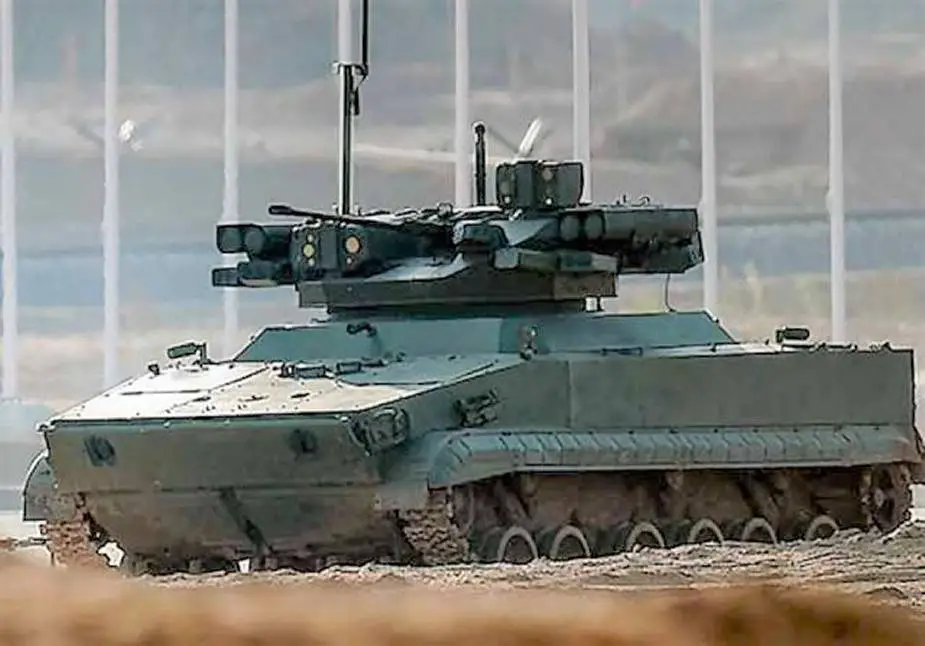Breaking news
Russian Udar UGV to learn to interact with drones.
Russia’s latest Udar robotic vehicle will be capable of moving on the battlefield autonomously and interacting with drones, Armament Cluster Industrial Director at the state tech corporation Rostec Bekkhan Ozdoyev told TASS on February 11. The Udar robot based on the BMP-3 infantry fighting vehicle was unveiled at the Russian Defense Ministry’s Innovation Day exhibition in 2015.
Follow Army Recognition on Google News at this link

The Udar robotic system has been developed on the basis of the BMP-3 infantry fighting vehicle. (Picture source: High Precision Systems Company)
The operational prototype of the Udar robotic system has been developed by the Signal All-Russian Scientific Research Institute within High Precision Systems Company integrated into Rostec. "When developing the Udar, the enterprise’s specialists tested the possibility of the robot’s movements in the autonomous mode. For this purpose, the vehicle integrates a motion planning subsystem based on sensors and measuring devices. Based on the data received, the robot’s route is formed, taking into account terrain features, and combat assignment parameters can be calculated," he said.
In developing robotic combat vehicles, the Signal Research Institute uses a unified robotics principle that implies outfitting existing models of military hardware with a set of equipment, the press office of High Precision Systems said. "The Udar robot, for example, has been developed on the basis of the BMP-3 infantry fighting vehicle. The same principle is used to robotize combat compartments: as of today, six different combat compartments mounted on the vehicle have been robotized," it said.
The Udar robot can also interact with unmanned aerial vehicles, the Rostec executive said. "We tested inter-operability with drones, including the tethered type with the electric power supply from the robot itself. Such drones can be used for conducting further reconnaissance and relaying the control radio channel," Ozdoyev added.
The robotic vehicle has been tested in inter-operability with lightweight robots designated for conducting reconnaissance, blowing up targets, transporting cargoes and evacuating the wounded. "A lightweight robot is mounted on or in the rear of the Udar vehicle and has a mechanism of simplified automatic undocking from the carrier before starting the fulfillment of the assigned task," the Signal Research Institute specified.

The Udar robotic system based on the BMP-3 during a demonstration in 2016. It is fitted with the Epoch remote weapon station.
The Udar UCGV was unveiled at the Innovation Days 2015 defense exhibition conducted by Russia`s Ministry of Defense. The robot took part in the live demonstrations during the event. It bridged several obstacles and destroyed several targets at the firing range. Udar is named "a state-of-the-art vehicle", as it is a heavy remotely controlled UCGV that can fire various types of weapons, ranging from light machineguns to heavy anti-tank missiles. VNII Signal is planning to integrate an artificial intelligence (AI) with the robot. As a result, Udar will be able to analyze combat environment and to work in the automatic mode.
The Udar UCGV is based on the BMP-3 infantry fighting vehicle (IFV) designed by the Tractor Plants Concern. It incorporates the Epokha remote controlled weapon station (RCWS) developed by the Tula-based Instrument Design Bureau (Russian acronym: KBP, a subsidiary of the High-Precision Weapons holding). Epokha is armed with a 30mm 2A42 automatic cannon (chambered for 30x165mm round), a Kalashnikov PKTM machinegun (chambered for 7.62x54R mm cartridge), and four ready-to-launch 9M133M-2 Kornet-M (NATO reporting name: AT-14 Spriggan) anti-tank guided missiles (ATGM). The module is a unified RCWS that can be installed on the newest armoured platforms developed by the Russian defense industry, namely Kurganets-25, Bumerang (Boomerang), and T-15 Armata IFVs. Udar will be able to gather intelligence data and to transport various cargoes in the automatic mode. The developers are planning to equip the vehicle with electronic warfare (EW) systems to jam the adversary`s hardware and pieces of instrumentation. It is noteworthy that the UCGV has retained the manual control mode.
More detailed specifications of the new UCGV are strongly classified. The robot is supposed to retain the basic armour protection of BMP-3 (Level 5 (K) STANAG 4569, all-round protection against 25mm armour-piercing fin-stabilized discarding sabot (APFSDS) rounds at 500 m distance) beefed up through the medium of upgraded Arena active protection system (APS). Udar is supposed to be able to transport up to eight mounted soldiers. The UCGV will be amphibious.



















